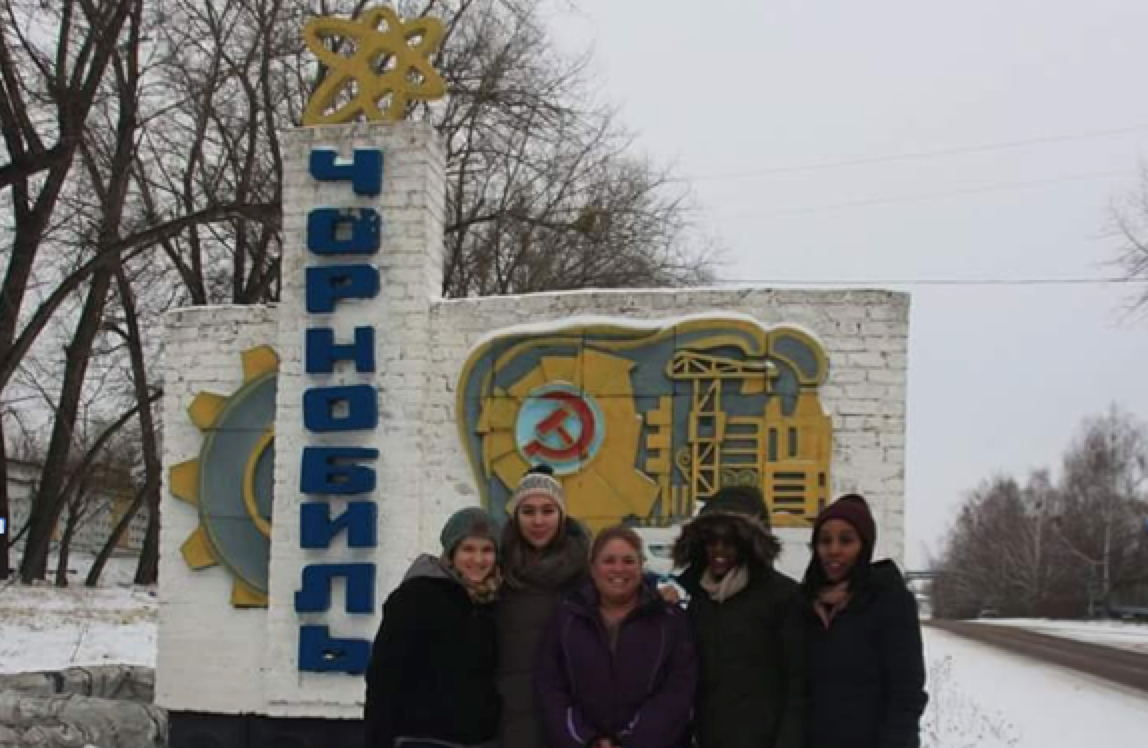
Dr. Danielle Ompad reports from Ukraine where she mentored the Ukraine 2018 Capstone Team.
Pictured above from left to right: Julia Dukach and Tetiana Saliuk from Alliance with Danielle Ompad, Hillary Dutton, Lindsey Killett and Kristina Sharifi at the Ukrainian National Ballet
Dear Colleagues,
Ukraine has the second largest HIV epidemic in Europe, second only to Russia. The key populations most affected by HIV in Ukraine are gay, bisexual, and other men who have sex with men (i.e., sexual minority men or SMM); people who inject drugs, and sex workers. Although new HIV infections have declined since 2010, approximately 17,000 new cases were reported in 2016. Kyiv signed the Paris Declaration on ending the AIDS epidemic in cities, making it one of two cities along with Odessa in Eastern Europe and Central Asia to do so. As a result, there is interest and enthusiasm for implementing prevention programs for key populations.
I have been working with the Alliance for Public Health (Alliance) for the past four years. Alliance is one of the leading organizations in Ukraine’s response to the HIV/AIDS epidemic and works closely with civil society organizations, the Ministry of Health, and other governmental organizations. It manages prevention programs and provides technical assistance along with financial support. It is currently conducting a pilot pre-exposure prophylaxis (PrEP) study in Kyiv in partnership with a local LGBT non-governmental organization (NGO) and the governmental AIDS centers.
Alliance is working with its third Capstone team this year. Jyotsna Atchula, Hillary Dutton, Lindsey Killett, Wangui Mwaniki, and Kristina Sharifi are using an implementation science framework to explore barriers and facilitators to scaling up PrEP for HIV among SMM. This project is related to one of last year’s Capstones, where a team produced a cost analysis of two different approaches to PrEP dissemination.
The 2018 Ukraine Capstone team travelled to Kyiv in mid-January, leaving later than the other Capstone teams because the Ukrainian Orthodox Christmas is in January. The plan was to interview NGO staff, physicians, and PrEP pilot program clients. The interviews were guided by the Consolidated Framework for Implementation Research (CFIR) and were designed to explore community, organization, and policy barriers and facilitators to the program’s scale-up.
One of the lessons the team learned was that public health researchers need to be flexible. Two days before arriving in Kyiv, we received an email telling us that the PrEP pilot had not started due to bureaucratic delays. But the team did not panic! Alliance still had interviews lined up for them with NGO staff and physicians, so they simply revised the qualitative interview guides to reflect what those key informants anticipated the barriers and facilitators to PrEP scale-up would be. With their translator, Alex, the team walked through snowy Kiev to conduct their interviews. When not in the field, they transcribed their interviews and began discussing the coding scheme they will develop. Although thematic analyses are ongoing, the team noted there was a lot of enthusiasm for PrEP, but concern about its sustainability.

Picture left to right: Alex Quartalny (translator), Hillary Dutton, Lindsey Killett, and Wangui Mwaniki on their way to interview NGO staff
In addition to work on their Capstone project, the students and I visited Chernobyl, the site of a devastating nuclear disaster in April 1986, which occurred during a test of some systems in Reactor 4. There was an accident and a series of explosions in the core, resulting in a huge cloud of radioactive material being released into the air. Radioactive material fell over much of Europe, and villages within a 30-kilometer radius were eventually evacuated. They remain abandoned, with the exception of a few people who have come back despite governmental warnings.

Pictured above from left to right: Hillary Dutton, Kristina Sharifi, Danielle Ompad, Lindsey Killett, and Wangui Mwaniki in front of the Chernobyl sign
Our visit to Chernobyl highlighted the heroic efforts of Chernobyl staff as well as the military in containing the core. One monument is dedicated “to those who saved the world.” We walked through the mostly abandoned town of Prypyat and buildings in two smaller villages. We also learned about the acute radiation sickness that affected the workers, as well as the cancer rates among exposed people. Thyroid cancers are among the most common Chernobyl-related cancers, as Iodine-131 was one of the isotopes released, with exposure occurring by inhalation and ingestion of contaminated dairy products.

Picture: The new sarcophagus over Reactor 4 was slid into place in November 2016.
What else did we do in Ukraine? We went to see a performance of Cinderella by the Ukrainian National Ballet. We shopped for nesting dolls and Soviet propaganda posters and enjoyed the many beautiful Orthodox churches. And, much to the team’s delight, we enjoyed the cuisines of Georgia, Lebanon, Ukraine, and Uzbekistan. The general consensus was that Kyiv is a special city worth visiting again.
Danielle Ompad
Associate Professor